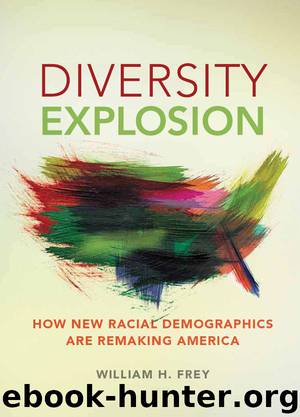Diversity Explosion: How New Racial Demographics are Remaking America by William H. Frey

Author:William H. Frey
Language: eng
Format: mobi
Publisher: Brookings Institution Press
Published: 2014-11-18T14:00:00+00:00
Some of the trends spurring these shifts were suggested in the 1990s.20 One is the continued decline in segregation in southern areas that are magnets for both blacks and whites as well as in areas in the West where new suburban housing continues to be constructed. As more of the black population moves to these areas, fewer of the nation's blacks will live in highly segregated neighborhoods.21 The pattern of declining segregation is beginning to spread outward from Atlanta, Dallas, and other larger southern metropolitan areas. For example, Tampa, Bradenton, and Lakeland, in Florida, are among the cities where segregation has declined markedly since 1990. In the North, black population losses in cities, the destruction of large public housing projects, and increased suburbanization of blacks are contributing to declines in segregation. In Detroit, segregation levels declined from 88 in 1990 to 75 in 2010. Chicago and Cleveland, among others, also experienced marked declines during this period (see figure 9-2).
Another impetus toward less segregation is the growth of the Hispanic and Asian populations. Although all minority groups still show a preference for members of their own group as neighbors, there is also tolerance for other groups, particularly in multiracial settings.22 That leaves open the possibility that in metropolitan areas where blacks are one of two or more major minority groups, other minorities can serve to “buffer” these divisions. In the 1980s and 1990s, there already was a marked tendency for black-white segregation to decline in multiracial metropolitan areas, especially those in Melting Pot regions such as Houston, Dallas, Los Angeles, and Riverside.23 The 2010 census shows that some of the lowest black-white segregation scores are in areas with large or growing new minority populations, including Phoenix, Las Vegas, Riverside, Tucson, Stockton, and San Antonio. Several southeastern areas that have had notable recent declines in black-white segregation, such as the cities in Florida cited above, also are home to substantial Hispanic populations. The increased multiracial character of New Sun Belt metropolitan areas, both inside and outside the South, should pave the way for even further attenuation of segregation in metropolitan areas.
Another reason to expect further meaningful declines in black-white segregation is the emergence of the black middle class, discussed in chapter 6, along with the increased ability of blacks to translate economic advancement into housing in less segregated and higher-quality neighborhoods. Because of the refusal of whites to accept any blacks in their neighborhoods, there was scant evidence as recently as 1980 of any translation of improvement in blacks’ personal economic circumstances into better neighborhood quality. White attitudes began to change in the 1990s. Although—limited by persistent discriminatory attitudes and social inertia—blacks still are less able to make this transition than Hispanics or Asians, upper-income and more educated blacks are now more able to live in integrated, well-off neighborhoods than blacks who are less well off.24 Segregation also is less prevalent and becomes even more reduced in metropolitan areas where there is greater convergence of black and white incomes.25 The upward mobility of a segment of the black population now brings the promise of greater declines in segregation.
Download
This site does not store any files on its server. We only index and link to content provided by other sites. Please contact the content providers to delete copyright contents if any and email us, we'll remove relevant links or contents immediately.
| Anthropology | Archaeology |
| Philosophy | Politics & Government |
| Social Sciences | Sociology |
| Women's Studies |
Nudge - Improving Decisions about Health, Wealth, and Happiness by Thaler Sunstein(7487)
iGen by Jean M. Twenge(5344)
The Fire Next Time by James Baldwin(5215)
Adulting by Kelly Williams Brown(4458)
The Hacking of the American Mind by Robert H. Lustig(4276)
The Sports Rules Book by Human Kinetics(4236)
The Ethical Slut by Janet W. Hardy(4155)
Captivate by Vanessa Van Edwards(3777)
Mummy Knew by Lisa James(3595)
In a Sunburned Country by Bill Bryson(3460)
The Worm at the Core by Sheldon Solomon(3406)
Ants Among Elephants by Sujatha Gidla(3376)
Suicide: A Study in Sociology by Emile Durkheim(2959)
The Slow Fix: Solve Problems, Work Smarter, and Live Better In a World Addicted to Speed by Carl Honore(2924)
The 48 laws of power by Robert Greene & Joost Elffers(2911)
Humans of New York by Brandon Stanton(2761)
Handbook of Forensic Sociology and Psychology by Stephen J. Morewitz & Mark L. Goldstein(2645)
The Tipping Point by Malcolm Gladwell(2640)
The Happy Hooker by Xaviera Hollander(2634)
